Range Rover Evoque: Seats - System Operation and Component Description
Control Diagram
NOTE: A = Hardwired; N = Medium speed CAN (controller area network) bus; O = LIN (local interconnect network) bus
CONTROL DIAGRAM - FRONT POWER OPERATED NON-MEMORY SEATS
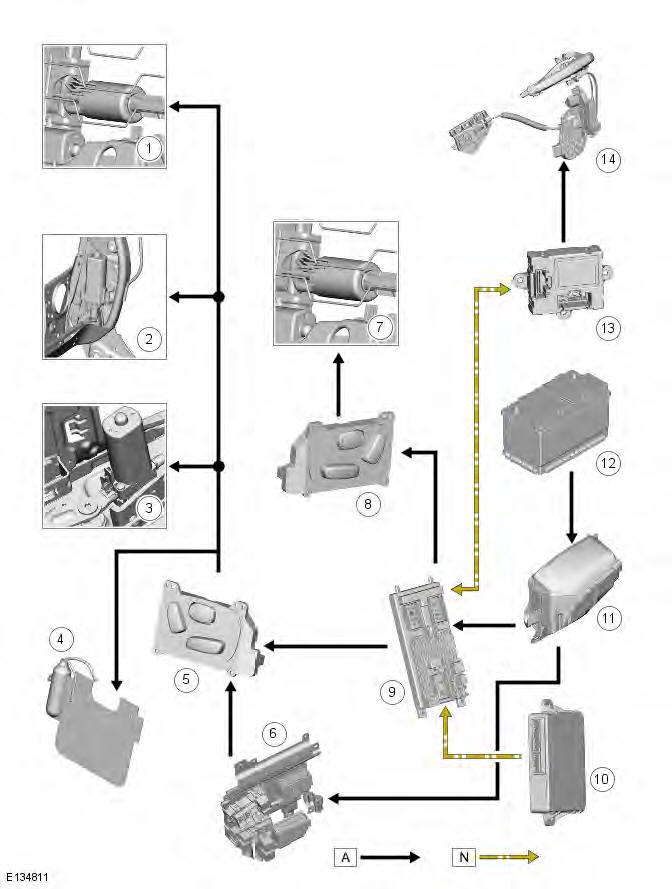
- Driver seat forward-rearward motor
- Driver seat recline motor
- Driver seat height motor
- Driver lumbar pump
- Driver seat switch pack
- RJB (rear junction box)
- Passenger seat forward-rearward motor
- Passenger seat switch pack
- CJB (central junction box)
- Keyless Vehicle Module (KVM)
- BJB (battery junction box)
- Battery
- Driver door module
- Driver door latch with ajar switch
CONTROL DIAGRAM - FRONT POWER OPERATED MEMORY SEAT
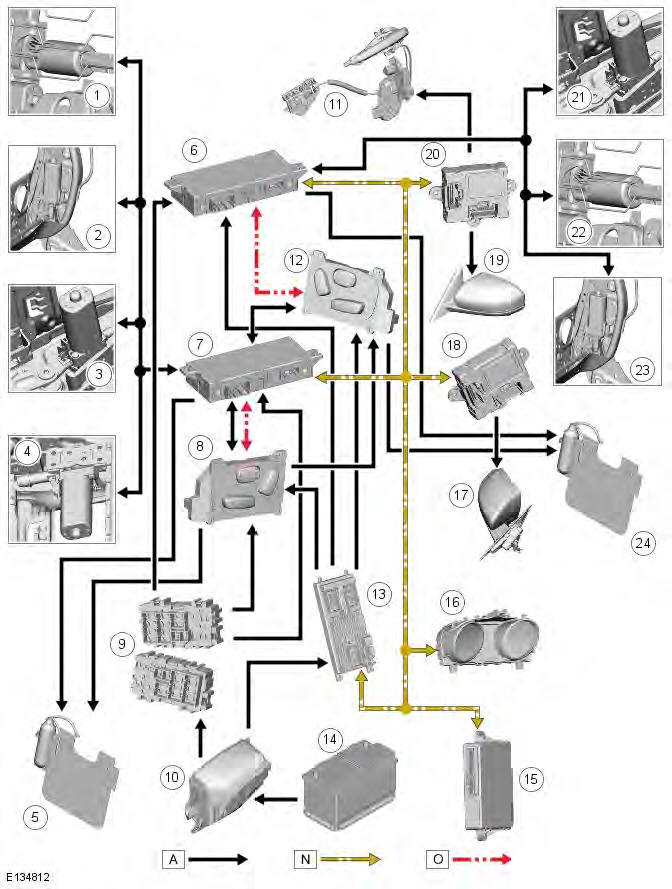
- Driver seat forward-rearward motor
- Driver seat recline motor
- Driver seat height motor
- Driver seat tilt motor
- Driver lumbar support
- Passenger seat memory module
- Driver seat memory module
- Driver seat switch pack
- RJB
- BJB
- Driver door latch with ajar switch
- Passenger seat switch pack
- CJB
- Battery
- Keyless Vehicle Module (KVM)
- Instrument cluster
- RH (right-hand) door mirror
- Passenger door module
- LH (left-hand) door mirror
- Driver door module
- Passenger seat height motor
- Passenger seat forward-rearward motor
- Passenger seat recline motor
- Passenger lumbar support
CONTROL DIAGRAM - FRONT SEAT HEATING
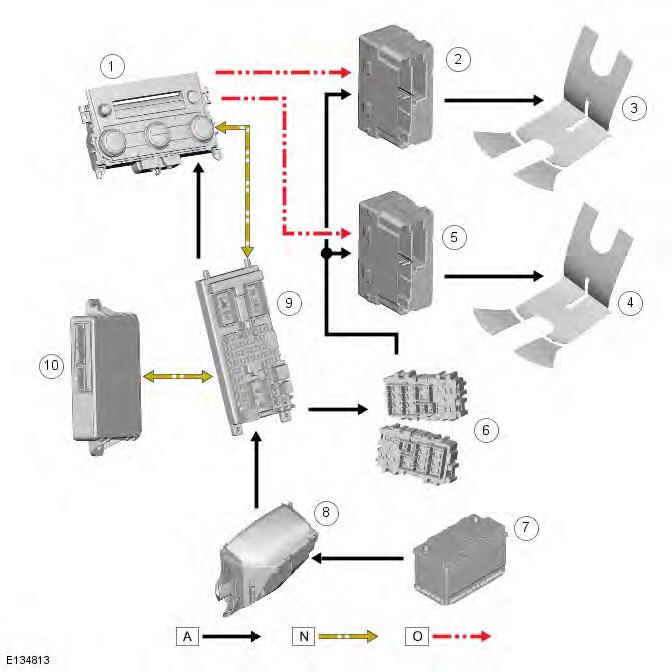
- ATC (automatic temperature control)
- Passenger heated seat module
- Passenger heated seat
- Driver heated seat
- Driver heated seat module
- RJB
- Battery
- BJB
- CJB
- Keyless Vehicle Module (KVM)
System Operation
PRINCIPLES OF OPERATION
Front Power Operated Non-Memory Seats
The driver's and passenger non-memory seats both operate when the ignition is in power modes 4 (Accessory) and 6 (Ignition), and will not operate during power mode 9 (Engine crank).
Power for front passenger seat operation is supplied from the Rear fuse box via a passenger seat power relay to the passenger seat control switch pack. Power for the driver's seat operation is supplied directly from the CJB to the driver's seat control switch pack. The front passenger and driver seat power supplies are controlled by the CJB. The seat switch pack directs the voltage to the relevant seat adjustment motor when a seat control switch is pressed. Two pins within each of the seat switch packs control the seat motors. Both pins are normally connected to ground.
The driver and passenger switch packs are also connected in circuit with a battery-saver timer relay that is located in, and controlled by the CJB. The battery-saver timer relay allows operation of the driver and passenger seat controls for 10 minutes after the engine is switched off, and the ignition is then selected to an appropriate power mode. The 10 minute timer is reset if the appropriate ignition power mode is retained and the driver's door is opened or closed. The driver and passenger seat operation is inhibited immediately following central locking of the vehicle.
Operating a seat motor control switch applies voltage to one of the pins while the other pin remains connected to ground.
Operating the seat motor control switch in the opposite direction reverses the power and ground connections to the motor, allowing the motor pinion to rotate in the opposite direction. In the event that a motor seizes or sticks, an internal thermal cut-out switch will trip to remove voltage from the motor.
Driver's Power Operated Memory Seat
The driver's memory seat will operate when the ignition is in power modes 4 (Accessory) and 6 (Ignition), and will not operate during power mode 9 (Engine crank).
Power for the driver's memory seat operation is supplied directly from the CJB to the power seat module. The memory seat switch pack is connected to the power seat module that controls the operation and memory position of the individual seat motors. The power seat module is connected on the medium speed CAN bus to the CJB and the front LH and RH door control modules.
The power seat module is also connected in circuit with a battery-saver timer relay that is located within, and controlled by the CJB. The battery-saver timer relay allows operation of the seat controls for 10 minutes after the engine is switched off, and the ignition is then selected to an appropriate power mode. The 10 minute timer is reset if the appropriate ignition power mode is retained and the driver's door is opened or closed. The driver's seat operation is inhibited immediately following central locking of the vehicle.
Requests for memory exterior mirror movements for a memory recall are transmitted on the medium speed CAN bus by the power seat module to the front door control modules. The front door control modules directly control the memory store and recall positions for the memory exterior mirrors. For additional information, refer to: (501-09 Rear View Mirrors)
Rear View Mirrors (Description and Operation),
Rear View Mirrors (Description and Operation),
Rear View Mirrors (Description and Operation).
Power Seat Module
The power seat module features driver selectable functions, and automatic monitoring functions.
Driver Selectable Functions
- Seat and exterior mirror memory recall
- Immediate seat adjustment.
Seat and exterior mirror memory recall function
The memory recall function sets the driver's seat to a stored position, and is activated when a switch pack memory position button is pressed. When memory recall is initiated, only 2 seat adjustment motors will operate at any one time to limit the overall current consumption. To further minimize the current load as the motors energize, the initiation of each of the 2 operating motors is phased with a 10 millisecond delay. The cushion slide and backrest will move first, followed by the cushion height.
As soon as the seat switch pack memory position button is pressed, a message is transmitted by the power seat module on the medium speed CAN bus to the front door control modules. The door control modules then activate the memory recall positions for the exterior mirrors. The instrument cluster message center will display memory recall messages when a memory recall is activated.
The memory recall function operates with 2 separate modes; the operation of each mode is dependent on the vehicle status when the seat memory position button is pressed.
Memory recall operating modes
- One-touch mode
- Proportional mode.
One-Touch Mode
When the vehicle is stationary and a switch pack memory position button is pressed, the memory recall function will operate in 'one-touch' mode. One-touch mode allows the seat and exterior mirrors to immediately move to the requested stored memory position.
If a seat adjustment or memory position button is operated during memory recall 'one-touch' mode, the current memory recall will be cancelled and the seat (and exterior mirrors via the medium speed CAN bus) will immediately stop moving.
The seat will then commence moving in the direction that corresponds to the pressed switch.
Memory recall is also immediately cancelled if the vehicle is driven from the stationary position before the seat has reached the requested memory position.
Proportional Mode
If the vehicle is already in motion when the switch pack memory position button is pressed, the memory recall function will operate in 'proportional' mode. Proportional mode recalls the seat (and exterior mirror) position for the duration that the memory switch is held in the pressed state. When the memory position button is released the memory recall will immediately stop, unless the seat has already reached the intended memory position.
In order to reach the intended stored memory position while the vehicle is moving, the memory position button must not be released until all seats, and exterior mirror movements are complete.
Immediate seat adjustment function
The immediate adjustment function is activated when a switch pack seat position switch (recline, slide, tilt or height) is operated.
Pressing any of the seat adjustment switches will initiate the corresponding direction motor to move the seat in that direction, until the switch is released. Only 2 seat motors will operate at any one time.
Automatic Monitoring Functions
The power seat module automatic monitoring functions are detailed as follows:
- Stall detection mode
- Sleep mode
- Battery monitor mode.
Stall detection mode
A seat motor is deemed to have stalled if there is no change in the input that is received from the corresponding feedback sensor for 200 milliseconds, while that axis is being driven.
If a stall condition is detected by the power seat module then the drive to that axis is cancelled for the remainder of that memory operation (memory recall), or until the switch is re-selected (immediate seat adjustment).
For all seat motor manual movements during an immediate seat adjustment function, when a motor is driven and a stall occurs the power seat module records and stores the stall position (soft stop) that the stall occurred. If movement occurs beyond the stored soft stop stall position, then the stall position is erased from the power seat module memory. This will always allow movement past a previously recorded stall position once movement has been registered beyond that position (i.e. by pressing the switch for longer than 100ms - soft-stop override time).
If the motor movement has stopped due to a motor stall (seat obstruction for example), once the obstruction is cleared then that axis may be activated again to move past the new soft stop stall position by re-selecting the appropriate switch and pressing for longer than 100ms. If the switch is not operated to move the seat past the new soft stop position, this position will remain stored in the power seat module memory as the full axis movement.
If motor movement has stopped due to loss of sensor feedback (sensor or wiring failure) then that axis may be activated again to move past the stall position by re-selecting the appropriate switch and pressing for longer than 100ms. This allows control of the motor to be maintained if sensor feedback is lost.
Upon re-selection of movement, if sensor pulses are detected then the motor will continue to be driven until the switch is released or another stall condition is detected. If sensor feedback is not detected then the motor is only driven for 0.5 second and then stops, until the switch is released and then pressed again for longer than 100ms, when a further 0.5 second of activation is permitted and so on. This is known as 'inch mode'.
If there is a failure with the medium speed CAN bus network, the seat will operate in 'inch mode'.
NOTE: For diagnostic purposes, an indication of medium speed CAN bus disconnection is apparent if the seat is operating in 'inch mode' and either the seat control module, CJB or door control modules are not shown connected to the medium speed CAN bus.
Sleep mode
The power seat module features a sleep mode to reduce power consumption to the required minimum.
If the power seat module is being prevented from entering sleep mode due to motor movement, memory recall or switch pack operation, then the module will enter sleep mode when the current function has terminated.
NOTE: In the case of a memory recall, all memory recall operations are carried out before the power seat module enters sleep mode, and not just the current motor movement.
The power seat module will exit sleep mode when any CAN bus activity is detected.
Battery monitor mode
The power seat module monitors the input power supply to make sure there is sufficient battery voltage available for engine cranking. If the battery voltage drops below 10.5 volts, then the power seat module ignores all requests for a memory recall until the battery voltage is greater than 11.0 volts.
If the battery voltage drops below 8.5 volts, then the power seat module ignores all requests for seat movement until the battery voltage is greater than 9.0 volts.
If the battery voltage is greater than 16.5 volts, then the power seat module ignores all requests for seat movement until the battery voltage drops below 16.0 volts.
Component Description
FRONT SEAT CONSTRUCTION
The front seat base is manufactured from high strength steel extrusions designed to exceed current legal strength requirements. The seat base is molded to form an anti-submarine hollow that will retain the occupant in the seat during a front end collision. The seat backrest is manufactured from high strength steel and features a wire suspension system to provide increased comfort. The backrest is attached at both sides of the seat base with a high strength steel bracket and pivot.
The seat base and backrest are inlayed with formed sections of dual hardness, molded foam to form the seat squab and cushion. The seats are designed to provide support, comfort and an ergonomic position for the driver and passenger.
The driver and passenger front seats are provided with additional safety features. The front driver's seat is installed with a seat position sensor; the front passenger seat is installed with an occupancy classification system sensor (dependent on vehicle specification) and an occupancy detection system. Both the driver's and passenger seat safety features provide inputs to control the deployment of the air bags and seat belt pretensioners. For additional information, refer to: (501-20B Supplemental Restraint System)
Air Bag Supplemental Restraint System (SRS) (Description and Operation),
Air Bag Supplemental Restraint System (SRS) (Description and Operation),
Air Bag Supplemental Restraint System (SRS) (Description and Operation).
The front seat belt buckles are mounted integrally with the seats to provide increased anchorage and occupant restraint.
For additional information, refer to: (501-20A Safety Belt System)
Safety Belt System (Description and Operation),
Safety Belt System (Description and Operation),
Safety Belt System (Description and Operation).
MANUALLY OPERATED FRONT SEATS
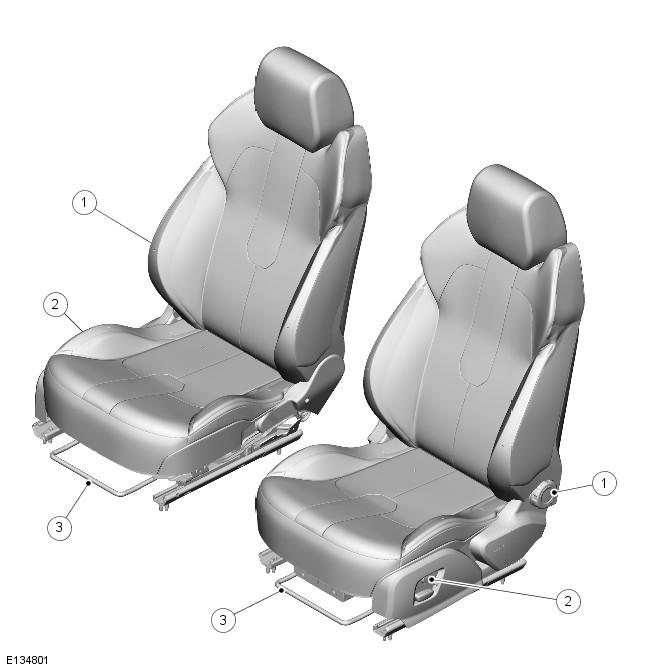
- Seat recline wheel
- Seat height switch
- Seat slide lever
The manually operated front seats provide a 4-way adjustable passenger seat with forward-rearward, incline-recline functions, and a 6-way adjustable driver's seat with manual forward-rearward and incline-recline functions and electric raise-lower functions. Operation of the seat adjustment levers will move the seat in the corresponding direction. For additional information on the manual seat controls, refer to the relevant section of the Owner's Handbook.
FRONT POWER OPERATED NON-MEMORY SEATS
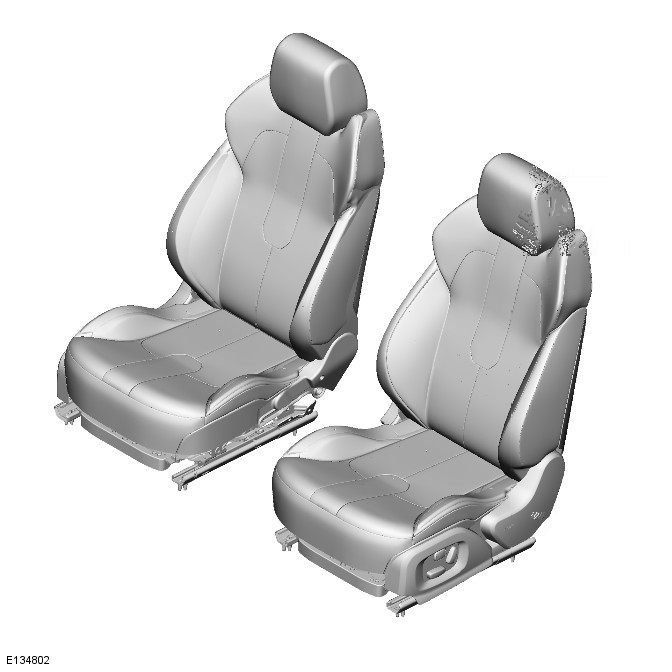
The driver's non-memory seat is 6-way adjustable with forward-rearward, raise-lower, incline-recline functions and lumbar support; the passenger non-memory seat is 4-way adjustable with forward-rearward, incline-recline and lumbar support functions. Height adjustment is not required for the passenger seat.
Front Non-Memory Seat Switch Pack and Motors
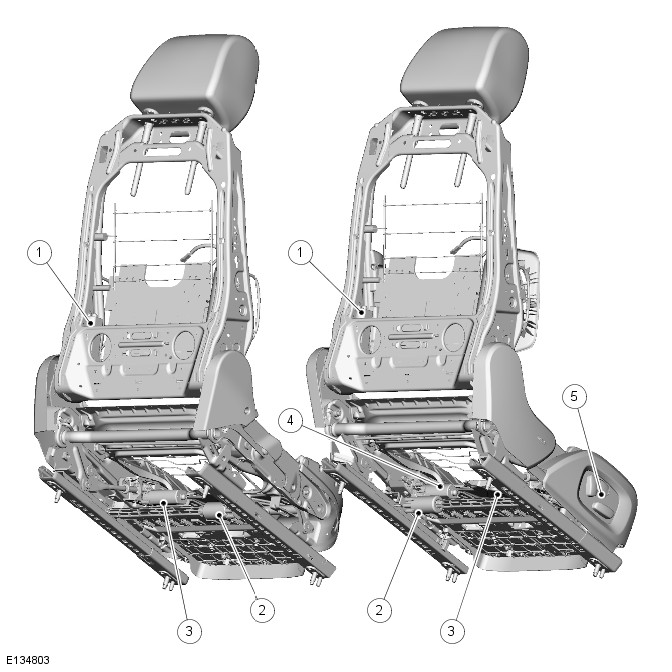
- Seat recline motor
- Seat slide motor
- Seat height motor
- Seat tilt motor
- Seat switch pack
Movement of the seat is achieved using the control switch pack located on the outboard side of the seat. The seat control switches directly operate the corresponding seat adjustment motors, mounted to the seat frame and backrest. For additional information on the power operated non-memory seat controls, refer to the relevant section of the Owner's Handbook.
The seat adjustment motors are a permanent magnet motor type, coupled to a rack and pinion assembly.
DRIVER'S POWER OPERATED MEMORY SEAT
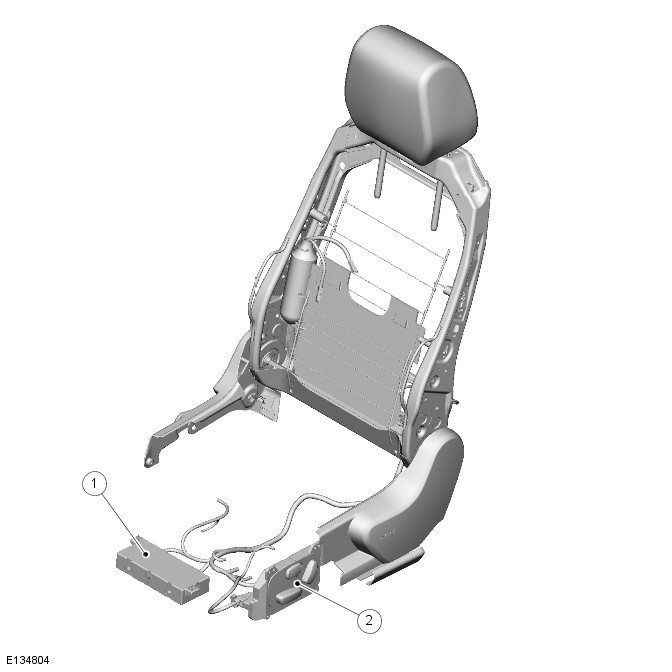
- Seat memory module
- Seat switch pack
The front power operated seats with memory is 8/8-way adjustable (electric driver & passenger adjustment including slide, height, recline, tilt and memory) and comprises almost the same control components as the front non-memory seats. The seat incorporates a power seat module located under the seat frame that allows up to 3 memory positions for the seat to be stored and recalled. If memory exterior mirrors are installed, the power seat module also initiates movement of the exterior mirrors by transmitting a command signal to the front door control modules when the seat memory position is recalled. The front door control modules are used to store and recall the memory exterior mirror positions.
Power Seat Module
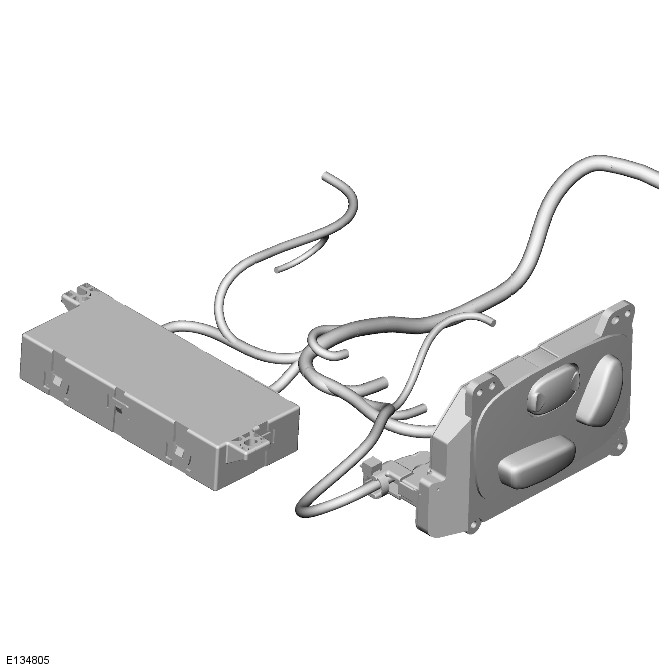
The power seat module is connected in the wiring between the seat switch pack and seat adjustment motors. The module contains a non-volatile EPROM (erasable programmable read only memory).
The power seat module monitors the seat positions and stores information provided by the seat track Hall sensors. The Hall sensors are incorporated within the seat adjustment motors. All seat memory values and current seat motor positions are stored in the EPROM.
In the event of a power loss, when power is restored the current motor positions are recalled from the EPROM and adopted as the current positions. This will allow the relative memory positions to be retained without any need to recalibrate the power seat module.
The power seat module is able to be 'flashed' for service updates or interrogated using the Land Rover approved diagnostic equipment.
Up to 3 different seat positions are able to be stored in the power seat module. Seat positions are stored in memory by pressing the memory button (M), and then 1 of the 3 memory store buttons (1, 2, 3) within 5 seconds. The memory buttons are located on the switch pack. The switch pack memory buttons allow the driver to control the memory storage and recall operations for the seat and exterior mirrors. The switch pack buttons are non-latching, momentary action switches.
On vehicles installed with a high-line instrument cluster and the ignition switched on, the seat position memory store commands are displayed in the message center and a single chime is sounded to confirm the new seat position is saved.
NOTE: Low-line instrument clusters are not installed to vehicles equipped with a memory seat system.
Refer to: Information and Message Center (413-08 Information and Message Center, Description and Operation).
The power seat module provides the following driver selectable functions:
- Seat and exterior mirror memory recall
- Immediate seat adjustment.
For further operating details of the driver selectable functions, refer to the section 'Principles of Operation'.
The activity of the seat is automatically monitored by the power seat module. The module will react to motors that are not functioning correctly to an operation request, and will also aim to reduce power consumption during periods of inactivity.
The power seat module provides the following automatic monitoring functions:
- Stall detection mode
- Sleep mode
- Battery monitor mode.
For further operating details of the automatic monitoring functions, refer to the section 'Principles of Operation'.
Calibration of Power Seat Module
If the power seat module is replaced in service, the replacement module must be calibrated using the Land Rover approved diagnostic equipment. The calibration routine is necessary for the power seat module to reset the seat datum values.
FRONT SEAT HEATING
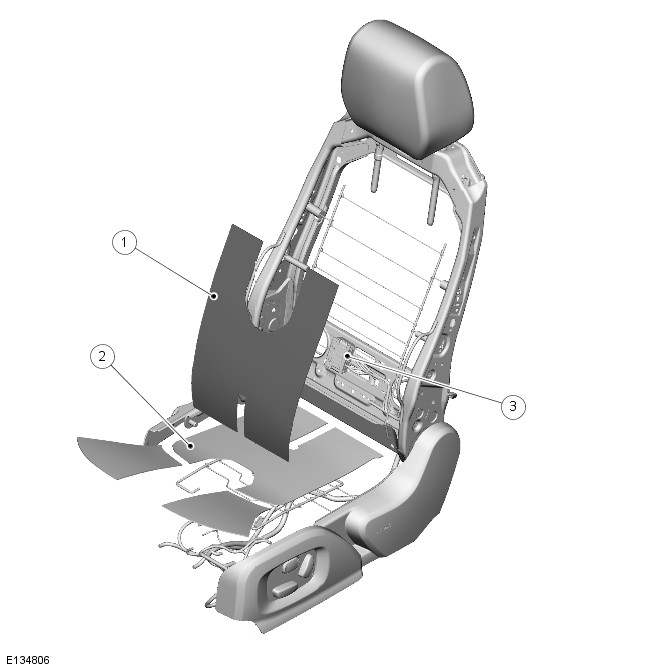
- Heated seat backrest element
- Heated seat cushion element
- Heated seat module
Depending on vehicle specification, seat heating is available for both the manually operated and the power operated seats. A heating element is incorporated within each seat cushion and squab. A seat heating module and electrical wiring is located beneath each front seat.
The seat heating modules are connected on the LIN bus to the ATC, and are also hardwired to the RJB for the power supply. A ground terminal from each seat heating module completes the circuit.
LUMBAR SUPPORT
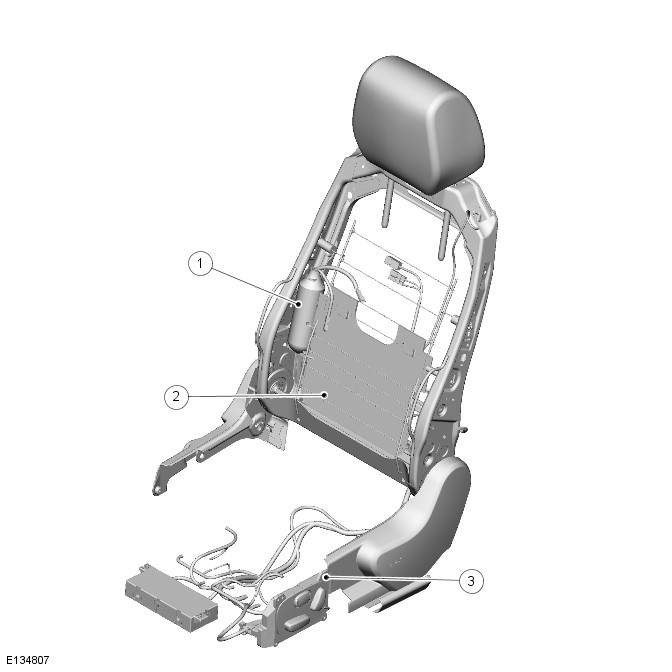
- Lumbar support pump
- Lumbar support air cells
- Lumbar support switch
Depending on the vehicle specification, the driver's seat only may incorporate a manually operated or a power operated lumbar support system.
Power Operated Lumbar Support
The power operated lumbar support system features a single motor driven pump and air cells. The air cells are mounted behind the seat squab. The lumbar motor is controlled using the lumbar switch mounted to the seat frame. Operation of the lumbar switch will energize the lumbar motor, and drive the pump to inflate or deflate the air cells.
Power for the lumbar motor is supplied and controlled by the CJB, via a battery-saver timer relay to the lumbar control switch. The lumbar control switch directs the voltage via a hardwired connection to the lumbar motor.
Lumbar position is not stored within the power seat module.
REAR SEAT
3-door version
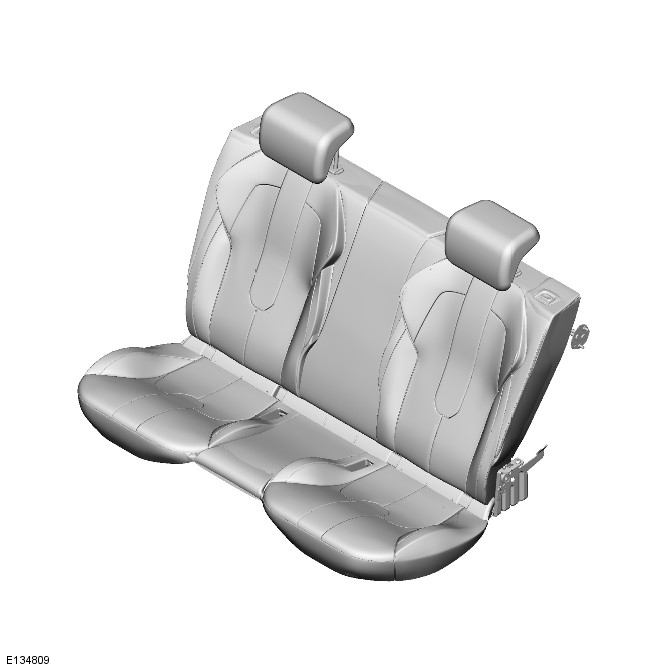
5-door version
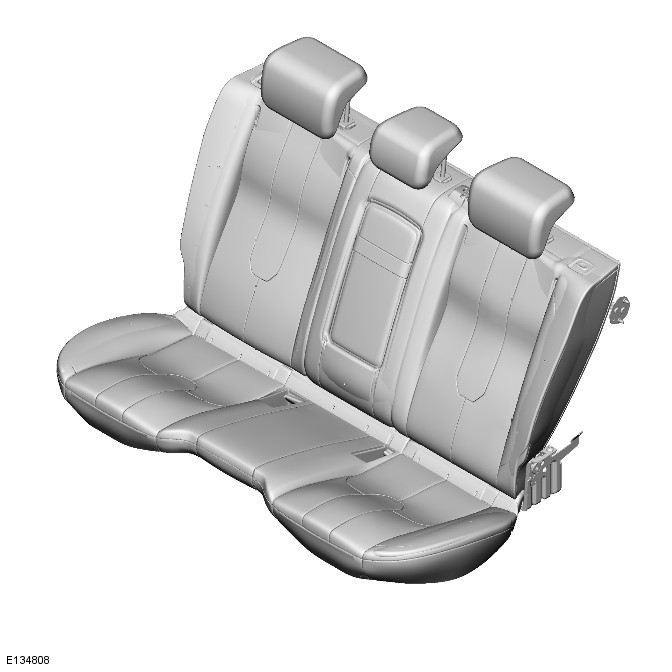
Back view with ISOFIX fastening points
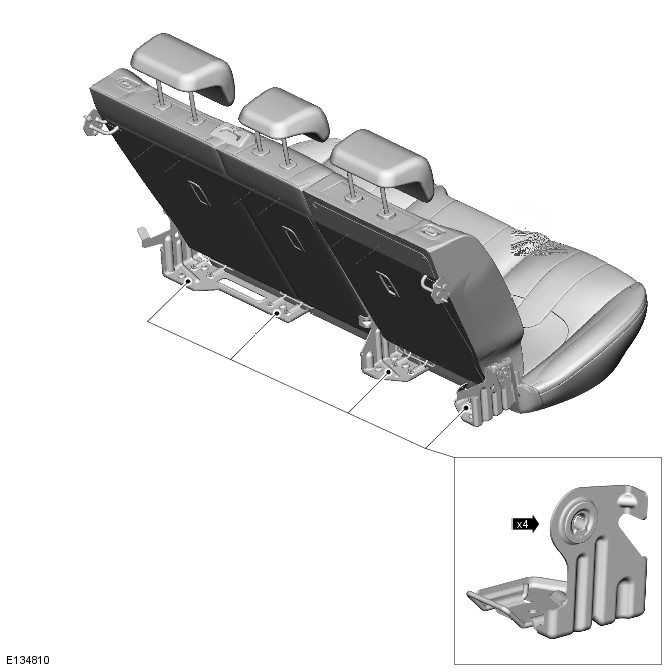
The rear seat is a 60/40 split configuration (3-seat bench seat in rear of 3-door version is optional, standard on 5-door), and is designed to fold in order to increase luggage capacity. Removal of the rear seat head rests will allow the seat to fold completely flat to the floor.
The rear seat is manufactured from 2 high strength steel extrusions that are joined at each end with a high strength steel bracket and pivot. The rear seat base is formed with an anti-submarine shelf that will retain the rear occupants in the seat during a front end collision.
The seat base and backrest are inlayed with formed sections of dual hardness molded foam that form the seat squab and cushion. The seats provide excellent support and comfort for the rear occupants.
An injection molded armrest with stowage tray is mounted in the center of the backrest, and may be folded down from the rear seat when the center position is not occupied.
ISOFIX fastening points are manufactured on the rear seat frame and are provided for secure fastening of compatible child safety seats to the 2 outer seat positions. The ISOFIX fastenings provide the safest method of child safety seat restraint, as the child safety seat is not able to roll or become detached from the rear seat, even during severe vehicle maneuvers.
Seating
Torque Specifications

*New nuts/bolts must be Installed

